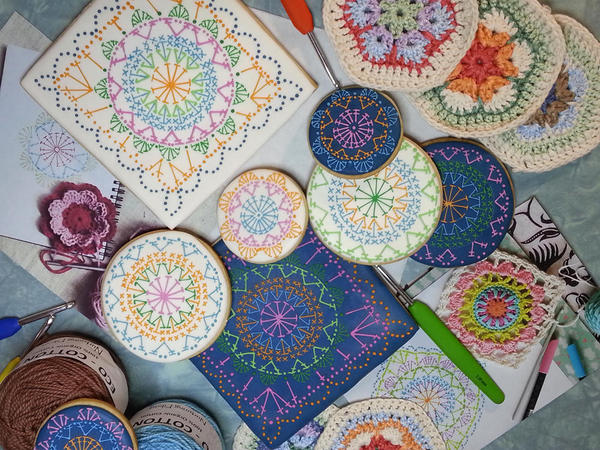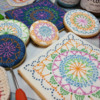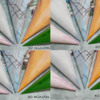[EDITOR'S NOTE: Hi, everyone! Welcome to our first installment of Toolbox Talk! And welcome to Liesbet Schietecatte, the Cookie Connection member who so generously volunteered to launch the idea! Thank you, Liesbet!
As I mentioned in a recent post, this idea spawned from a suggestion by Wildflower for a global tool "glossary" to help demystify differences in cookie decorating tools and ingredients in various parts of the world. Everyone here at Cookie Connection loved the idea behind the suggestion, but we felt that the task of building a comprehensive global "glossary" was far bigger than any one person, or even a small team, could undertake. That said, we decided to morph the idea of a "glossary" into a series of blog discussions designed to get us all talking on a global level about the products available in our own backyards.
Over time, as this assemblage of blog posts grows and gathers more input from you, we will hopefully be able to shape it into a more formalized "glossary". But, until then, we're using this format to get the dialogue started.
Anywho . . . Liesbet explains this approach far more poetically, using gorgeous "crocheted" cookies and other visual aids, no less! So, read on! And don't forget to share your experiences with baking paper - the subject of this first Toolbox Talk - in the comments below! ~ JMU]

The Toolbox Talk series will be a place where different strands of frustration, research, and suggestion come together like colourful yarn, hooked, woven, and sewn into an ever-growing blanket of comfort and understanding! ![]()
Crochet and knitting metaphors aside, its goal is to bring relief to cookiers who are struggling with ingredients and tools mentioned in recipes and tutorials from across the world - who aren't familiar with said things or even where to start looking for them. The entries here are not intended to provide a single, definitive, or necessarily 100 percent-accurate, answer, but are rather a starting point to which everyone else can add information, corrections, translations, shopping advice, and more.
As the suggestion for a tools "glossary" was made after a query about baking paper for piping cones, I chose baking paper [EDITOR'S NOTE: aka "parchment paper" or other names in other parts] as the subject for my first entry. I hope the letter “A” doesn’t feel offended, because I've skipped it to start with “B”aking paper to make “C”rochet cookies! ![]()
A Bit of Background
I like using cones for finer work or working with smaller amounts of royal icing, as in my crochet cookies above. I couldn’t get a nice result with paper cones, so I switched to cones made from cellophane. The latter can be very frustrating, as it is sometimes charged with static electricity that makes it difficult to fold, or to separate from other cones if you are as daft as me and stack cones into one another until you need them. One particularly frustrating evening, I posted that forum query I mentioned earlier about the right kind of baking paper to use for making pastry cones.
My issue with paper pastry cones was that the paper seemed to absorb moisture from the royal icing and leave the icing thicker than I wanted. I had to cut the tips repeatedly and lost the ability to do fine work. Laegwen and Wildflower came to the rescue and set me on the right path.
A note on the cookies: Their designs are based on crochet patterns developed by my friend Yuliya from Yuli Handmade. I chose them because they are an excellent way to showcase how fine detailing can be achieved with a pastry cone, and not just metal piping tips. The yarn and crochet hooks were provided by Gina from Natural Yarns. Thank you both!
Types of "Paper" and Their Characteristics
Since that forum post, I have compared four different kinds of baking or decorating "paper" available here in South Africa (namely, greaseproof paper, silicone-coated paper, wax paper, and cellophane) across a few dimensions (weight per square meter, feel and texture, and heat-resistance). I have also compiled some other information about how each is produced and the brands available in certain parts of the world . . . Please bear in mind that the data provided here are based on a limited sampling of South African brands, and also information provided by other Cookie Connection members in the USA and Germany. There is no claim made that the information provided here is completely exhaustive or accurate in all cases or countries. In fact, I welcome any corrections and exceptions in the comments below! ![]()
A: Greaseproof paper is "impermeable to oil and grease and is normally . . . produced by refining the paper stock and thus create [sic] a sheet with very low porosity." (Source: Wikipedia – greaseproof paper.) Or as Laegwen paraphrased information from her German supplier: “It is heat-resistant and greaseproof. This [state] is reached by grinding the wood pulp in a special way so that tiny hairs stick up and build a natural barrier for grease.” Lastly, a local South African supplier summarised this product as follows: “greaseproof paper has no coating, but is nonpermeable, so it prevents grease from seeping through."
Based on my evaluation, the main characteristics are: (1) a smooth feel on both sides; (2) a relatively high density (40 g/sq m or 0.13 oz/sq ft, though my local supplier indicated that heavier paper is available); (3) resistant to grease, but not to water; and (4) withstands temperatures up to 180°C (or 356°F). It is readily available in supermarkets in South Africa.
Common names (and brands):
South Africa: greaseproof paper (Sylko), baking paper
USA: uncoated parchment paper (not readily available in the USA; most parchment paper appears to be coated, see below)
Germany: uncoated backpapier (aka baking paper), sandwich paper
B: Silicone-coated paper is basically greaseproof paper coated with silicone on one or both sides. This coating makes it water-resistant and heat-resistant up to the following temperatures: 240°C (464°F) for South African papers, 220°C (428°F) for German papers, and 204 to 216°C (400 to 420°F) for American papers. It also gives the paper a slickness that allows two layers to slide over one another very easily, and makes the paper more resistant to tearing (for example, when you want to secure a cone with a notch where it has been folded over). Despite the extra coating, it weighs 40 to 48 g/sq m or 0.13 to 0.15 oz/sq ft - not that much more than uncoated greaseproof paper.
I have found it as pre-cut sheets and triangles, and on a roll. The baking paper with one-sided coating (Unsgaard) is readily available in South African supermarkets, but I could only find the paper with double-sided coating in baking supply shops.
[EDITOR'S NOTE: If you were wondering how Liesbet could tell that her paper was coated on one or both sides, so was I! I've never seen packaging in the USA that indicates this, let alone any silicone coating. Here's what she said: "The single-sided paper in South Africa has a very smooth side and a rougher (uncoated side). There are also templates/instructions printed on it in such a way that, when you put the paper down to read the text, you automatically have the silicone side facing up (to touch food) and the rough side facing down (to touch the baking sheet)."]
Common names (and brands):
South Africa: silicone sheets, silicone baking paper, and baking paper (Quilon, Unsgaard with coating on one side only)
USA: parchment paper (Reynolds, Wilton, and many private label/grocery store brands) [EDITOR'S NOTE: As I mentioned above, the American brands of parchment paper that I've used, namely all of the above, are silicone-coated, though the packaging typically only indicates that it is "non-stick". One must inspect the fine print on those brands' websites to get confirmation that these papers are silicone-coated. Neither packaging nor sites indicate whether the coating is on one or both sides, but it feels like it is on both.]
Germany: Backpapier or backpapier/antihaft beschichtet, or in English, baking paper or baking paper/non-stick coating (Lidl, Aldi, Penny, Toppits) [EDITOR'S NOTE: According to Laegwen, the standard German paper is silicone-coated, though, as in the USA, it may not be labelled as such.]
C: Wax paper is typically a lighter paper (30 to 34 g/sq m or 0.10 to 0.11 oz/sq ft) coated with wax on one or both sides, which makes it water- and grease-resistant in some cases. It is not recommended for baking cookies, as the paper may catch alight in the oven. It is too flimsy to fold into pastry cones easily.
D: Cellophane, though clearly not "paper", heat-resistant, or intended for baking, has been included here as an alternative to baking paper for making parchment cones. The cellophane I used is water-resistant and slightly less dense (36 g/sq m or 0.12 oz/sq ft) than either greaseproof or silicone-coated paper. It is more difficult to cut into triangles with straight edges, and can be static-y, as I noted earlier, stopping the "paper" from sliding over itself. It's also very difficult to fold over to secure the cone, so cones made of cellophane need to be closed with sticky tape.
A Practical Performance Test
I also compared the performance (feeling and piping control) of different papers available in South Africa in a practical test. I filled cones made with each of the papers with a different colour royal icing and documented observations at different time intervals.
From left to right in the image above, the cones are made of (A) greaseproof paper (pink icing), (B.1) double-sided silicone-coated paper (dark blue icing), (B.2) single-sided silicone-coated paper, with the coated side facing inward (light blue icing), (C) wax paper (orange icing), and (D) cellophane (green icing). [EDITOR'S NOTE: See those templates that Liesbet mentioned on cone B.2!]
In the image below, you can see how the icing from each cone behaved at time zero (right after the cone was filled) and at 10-minute time intervals thereafter.
The photo above doesn’t show all that much difference in piping behavior; the differences were more in the feel of working with the cones.
The greaseproof paper cone (A) felt like it was absorbing moisture from the icing. I had to snip the tip a little at 20 minutes into the test. (See the thicker line then.) The icing still seemed to flow the same, but it took more effort to pipe it; I had to squeeze the cone harder.
On the other hand, the wax paper cone (C) did not feel stiff at all, but rather mushy, as if it would pop open at the slightest pressure, allowing the icing to uncontrollably flow out.
Both silicone-coated paper cones (B.1 and B.2) handled very well, as did the cellophane cone (D).
I also took pictures of the cones at every interval (below) to compare moisture absorption from the icing. Moisture absorption started almost immediately in all of the true paper cones (A through C), but was the fastest in the wax paper (orange icing) and the slowest in the double-sided silicone-coated paper (second from left; dark blue icing). Naturally, the cellophane (green icing) didn't absorb any moisture and so the icing didn't seem to dry out as quickly in that cone. But cellophane had an issue of its own, in that a certain amount of separation occurred where the edges of the triangle overlapped.
When the test was finished and cones were emptied, I was left with the impression that the greaseproof paper had absorbed so much moisture that a lot of dried-out icing was staying behind in the cone. I tried to compare the cones on this point by weighing them when emptied, but my scale was not accurate enough to make precise statements. The "empty" greaseproof paper cone weighed about 6 grams, whereas the scale gave inconsistent readings (between 3 and 6 grams) for the "empty" cellophane and silicone-coated cones.
Summary: In my opinion, pastry cones are best made with double-sided silicone-coated baking paper. It's easiest to make cones with this paper, and these cones handle very well for piping. Plus, it's one of the most moisture-resistant "papers" (second only to cellophane), thus affecting icing consistency and flow very minimally.
As Toolbox Talk is intended to be a place for discussion, please join in with your experiences with different paper products, make corrections, and add to the list of products and brand names in your own country. Please also leave a note about any other tools or ingredients you would like me to discuss in future posts!

 Liesbet Schietecatte, born in Belgium but permanently living in South Africa since 2005, accidentally found her way into cookie decorating in 2012. Grabbing moments in between her career as an archaeologist and being a mommy and a wife, Liesbet bakes Belgian biscuits like speculoos in the tradition of her grandmother’s family who were bakers for several generations, but she gets the most creative satisfaction from decorating with royal icing. She bakes and decorates for occasional orders and at times for a crafters' market, but mostly for the enjoyment and challenge of trying out new things. To honour her family's baking legacy, Liesbet uses the family name to give a home to her baking pictures on Facebook: Stock’s – Belgian Artisan Bakes.
Liesbet Schietecatte, born in Belgium but permanently living in South Africa since 2005, accidentally found her way into cookie decorating in 2012. Grabbing moments in between her career as an archaeologist and being a mommy and a wife, Liesbet bakes Belgian biscuits like speculoos in the tradition of her grandmother’s family who were bakers for several generations, but she gets the most creative satisfaction from decorating with royal icing. She bakes and decorates for occasional orders and at times for a crafters' market, but mostly for the enjoyment and challenge of trying out new things. To honour her family's baking legacy, Liesbet uses the family name to give a home to her baking pictures on Facebook: Stock’s – Belgian Artisan Bakes.
Photo credit: Liesbet Schietecatte
Note: Toolbox Talk is a bimonthly Cookie Connection blog feature written by Liesbet Schietecatte that explores similarities and differences in cookie tools and ingredients from all over the world. Its content expresses the views of the author and not necessarily those of this site, its owners, its administrators, or its employees. Catch up on all of Liesbet's past Cookie Connection posts here.












Comments (25)